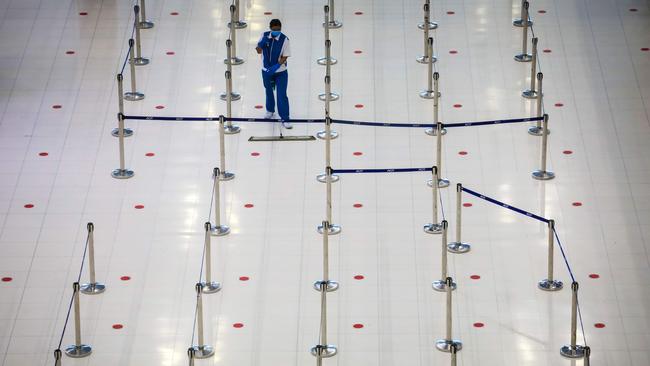Coronavirus: The essential workers who’ll keep Australia ticking along
The COVID-19 crisis will redefine the workforce and the jobs we consider critical in recovery.

Now that COVID-19 has forced a slowdown of the economy, it is our “essential workers” who keep Australia going.
Medical professionals are constantly exposed to the virus and work incredibly long hours to keep us safe.We have also learned to appreciate the crucial roles that supermarket shelf-fillers, warehouse personnel and delivery drivers fulfil. Commercial cleaners are now seen as indispensable in combating the spread of the disease.
While essential workers are putting in the longest and hardest shifts of their career, non-essential workers see huge changes to their jobs too. We’ve seen a mass migration from the office towers to the living rooms of Australia. Businesses that were reluctant to have their staff work from home managed within a week to transition to remote work and are now getting the hang of Zoom, Skype and Microsoft Teams. The keyboard warriors and working-from-home newbies were customers of non-essential businesses such as cafes, cinemas and department stores. These businesses closed their doors and many workers for the first time in their lives found themselves applying for government aid through Centrelink.
Let’s explore the role of essential workers over the coming months and see which non-essential workers are at the biggest risk of losing their jobs.
Since there isn’t an official and clear definition of what jobs are considered essential, I dived into the data and manually classified each job in Australia as essential or non-essential. A general problem with this methodology is that maybe not all 140,000 childcare professionals should be considered essential. As regulations are increasingly tightened and more children stay at home, fewer childcare workers should be considered essential. For the sake of this exercise, however, let’s assume all childcare workers are essential. Similar issues occur with many of the 500 different jobs that I had to classify.
The resulting data isn’t perfect but it’s very useful in understanding the big-picture impact that COVID-19 will have on Australia’s workforce and society, well beyond the main infection period.
By my methodology, about three million Australian jobs (about 30 per cent) are essential. Let’s see who these workers are and what their futures might hold.
Registered nurses are the largest essential profession (221,000). Nurses also are more exposed to COVID-19 than most other professions. The 149,000 truck drivers are more crucial than ever in ensuring supermarkets and pharmacies have everything we need. Teachers in primary schools (148,000), secondary schools (137,000) and university (49,000) are transitioning to online-only education while ensuring children continue to learn (good for their own future and the immediate mental health of parents).
Essential workers are less likely than non-essential workers to lose their job during the economic downturn. Non-essential government employees are also unlikely to lose their job even if their work isn’t too important — it’s simply more economical to keep non-essential government workers employed and pay them their standard wage instead of firing them and then paying for them through government benefits.
In Australia each profession is assigned an official skill level to indicate how much formal training and education it requires. Skill level 1 requires university education, skill level 3 requires a certificate (tradies and manufacturing workers) and skill level 5 doesn’t require a formal qualification, because you learn on the job (cleaners, shelf-fillers, mail sorters). As a rule of thumb, higher-skilled jobs pay higher wages.
Skill level 1 workers (doctors, nurses, pharmacists, etc) make up a larger share in the essential worker cohort (39 per cent) than among non-essential workers (29 per cent). Skill level 4 workers (truckies, personal-care workers, aged-care workers, etc) are also more common among essential workers (32 compared to 24 per cent). It is the workers in skill levels 2 and 3 that are less commonly found among essential workers. While 14 per cent of non-essential workers are classified as skill level 2, only 5 per cent of essential workers fall in the same category. The biggest discrepancy between essential (only 3 per cent) and non-essential workers (18 per cent) can be found in skill level 3.
Following the logic that non-essential workers are at a higher risk of losing their job we must conclude that skill level 3 workers are more likely than anyone else to lose their job during the economic slowdown. Skill level 3 workers are the traditional backbone of the Australian middle class. They are the metal fitters, concreters, bricklayers and manufacturing workers that build Australia. These skill level 3 jobs are especially vulnerable during the COVID-19 slowdown. Tradies can’t work from home and non-essential factories might have to lay off staff as sales decline. Job losses in the coming months will likely disproportionately hit skill level 3 jobs.
That’s terrible news for our tradies and manufacturing workers. The big government expenditure aimed at mitigating the economic damage, however, makes me hopeful that skill level 3 workers will find employment opportunities once the crisis is over.
The Liberal government showed that (despite traditional Liberal narrative favouring small governments and restricted government spending) it isn’t shying away from spending big money on the management of the crisis. Considering we have a decade of insufficient infrastructure investment behind us and that there will be enough local talent looking for work, I’d expect the Liberal government will launch a huge public works program once the crisis is over. I am envisioning a real nation-building program that can rally Australians around the shared goal of kickstarting the economy again. Our cities are in need of new rail, roads need to be repaired, utilities need to be upgraded, our digital infrastructure must be overhauled (especially since many more people will work from home in the future) and maybe the government would even throw in a big renewable energy project to appease the opposition and get young voters on board. The jobs that benefit most when a government invests in upgrading its infrastructure are the builders, tradies and local manufacturers of building materials — the skill level 3 workers.
Simon Kuestenmacher is director of research at The Demographics Group




To join the conversation, please log in. Don't have an account? Register
Join the conversation, you are commenting as Logout